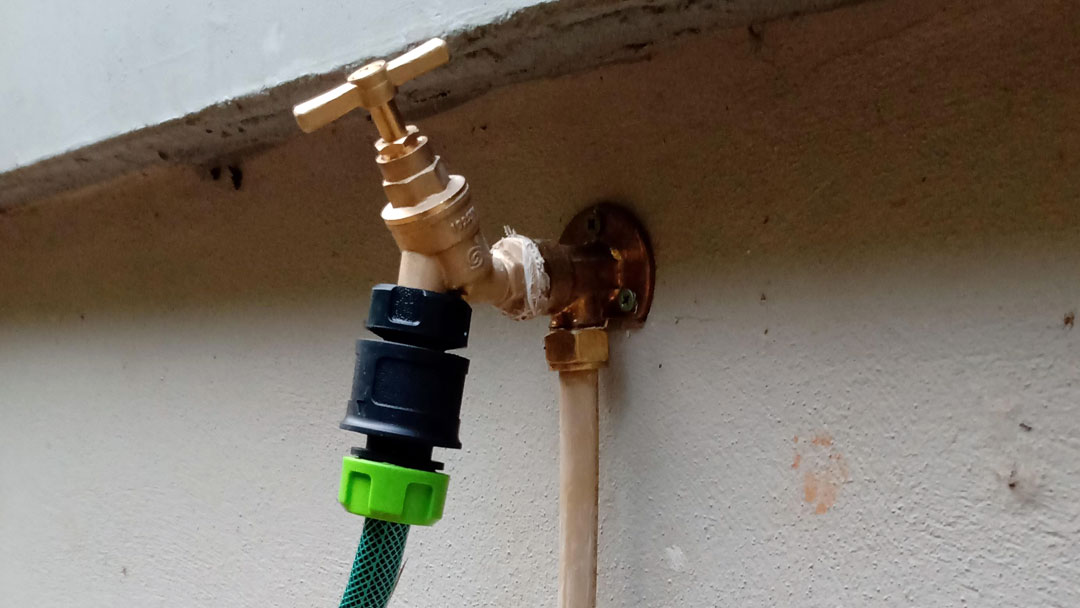A leaking outdoor tap is more than just an annoyance – it wastes water, increases utility bills, and may cause property damage if left unaddressed. This comprehensive guide will help you quickly identify the cause of your leak, implement immediate fixes, and perform proper repairs with minimal tools and expense. By following these instructions, most homeowners can resolve common outdoor tap leaks without professional assistance, potentially saving significant repair costs while conserving water resources.
Common Causes
Identifying Your Specific Leak Type
The first step to fixing your outdoor tap is determining exactly where and how it’s leaking, as this indicates different internal problems. Leaking taps typically exhibit specific patterns based on their underlying cause and some should be fixed immediately.
When your tap is leaking from the spout despite being fully closed, the most likely culprit is a worn washer or damaged valve seat. This manifests as persistent dripping even when the handle is turned firmly to the off position. The washer creates a seal against the valve seat, and when either component deteriorates, water continues flowing through the small gap between them.
If water appears around the handle or stem rather than the spout, this typically indicates problems with the packing nut or O-rings. You might notice moisture or small droplets forming around the base of the handle when the tap is both on and off. These components prevent water from escaping around the spindle that operates the internal valve.
Leaks occurring at the connection points between the tap and the wall suggest loose fittings or damaged threads. These appear as moisture around the base of the tap body or along connection points and often worsen when water pressure increases. In colder climates, such leaks may also indicate frost damage that has cracked the tap body or supply pipes.
What Different Leak Locations Tell You
The specific location of your leak provides valuable diagnostic information:
Spout leaks when turned off indicate:
- Worn rubber washer (most common and easiest to fix)
- Damaged valve seat (requires cleaning or grinding)
- Deteriorated jumper valve (in older tap designs)
Handle/stem leaks suggest:
- Loose packing nut (simplest fix)
- Worn O-rings or packing washer
- Damaged spindle
Base or connection leaks point to:
- Loose connections needing tightening
- Damaged threads requiring sealing
- Cracked components from freezing (most serious)
Understanding these distinctive patterns allows you to target your repair efforts precisely without unnecessary disassembly or parts replacement.
Quick Fix Solutions for Common Outdoor Tap Leaks
Before undertaking a complete repair, several quick fixes can temporarily resolve leaking issues while you prepare for permanent solutions.
For a tap leaking from the spout, try firmly closing the tap without excessive force. Sometimes mineral deposits prevent complete closure, and a gentle but firm turn might reseat the washer properly. If this doesn’t work, locating and shutting off the water supply to the outdoor tap will prevent further leakage until repairs can be made.
When dealing with a leak around the handle stem, tightening the packing nut often provides an immediate solution. This large nut sits just below the handle and can be carefully tightened with an adjustable wrench. Turn clockwise one-quarter turn at a time until the leak stops, being careful not to over-tighten which could damage internal components or make the tap difficult to operate.
For leaks at connection points, check if fittings can be tightened by hand first, then gently with a wrench if necessary. Applying plumber’s PTFE tape to threaded connections often resolves minor seepage without requiring component replacement.
Step-by-Step Repair Guide
Preparation and Safety Measures
Proper preparation ensures smooth, safe repairs. Begin by shutting off the water supply to your outdoor tap, which may be via an isolation valve inside your home or at the main water meter. Open the tap fully to drain any remaining water and release pressure from the line.
Gather all tools and replacement parts before disassembly to avoid leaving the project unfinished. Cover nearby drains to prevent small components from being lost, and ensure adequate lighting for working on small parts. For properties with multiple water zones, consider labeling connections before disassembly to ensure correct reassembly.
Repairing a Leaking Spout (Washer Replacement)
The most common repair for outdoor taps involves replacing the washer that seals the water flow when closed. Follow these systematic steps:
- With water supply off and tap opened to drain, remove the tap handle by unscrewing the visible center screw or prying off a decorative cap to access hidden fasteners.
- Use an adjustable wrench to unscrew the tap bonnet or headgear, turning counterclockwise. This exposes the internal spindle assembly containing the washer.
- Extract the spindle carefully, noting the orientation of all components for correct reassembly. The washer is typically located at the bottom of the spindle, held in place by a small screw.
- Remove this retaining screw, replace the old washer with a new one of identical size and type, and reattach the screw firmly but not excessively tight.
- Inspect the valve seat inside the tap body where the washer makes contact. If it appears pitted, corroded or uneven, it requires cleaning or grinding with a specialized reseating tool to create a smooth sealing surface.
- Reassemble the components in reverse order, ensuring all parts align correctly and thread properly without forcing connections.
Fixing Handle and Stem Leaks
Leaks occurring around the tap handle stem typically indicate issues with the packing nut or O-rings:
- After shutting off water and removing the handle, examine the packing nut directly under the handle.
- Try tightening this nut with an adjustable wrench, applying just enough force to stop the leak without restricting spindle movement.
- If tightening doesn’t resolve the issue, unscrew and remove the packing nut to expose the spindle and O-rings.
- Carefully note the arrangement of all components during disassembly to ensure proper reassembly.
- Remove the old O-rings from the spindle shaft and replace with new ones of identical size.
- Apply a small amount of silicone grease or specialized tap lubricant to the new O-rings before reassembly to prevent damage during insertion and extend their service life.
- Reinstall the spindle, ensuring O-rings seat properly in their grooves, then reattach the packing nut and handle.
Addressing Connection and Base Leaks
Leaks at the base or connection points of the tap require different repair approaches:
- Examine threaded connections for signs of damage or inadequate sealing.
- For simple loose connections, tighten fittings using two wrenches – one to hold the tap body stable and another to tighten the connecting nut.
- If threads are damaged or connections continue to leak after tightening, remove the fitting completely, clean thoroughly, and apply 5-6 layers of plumber’s PTFE tape in a clockwise direction before reconnecting.
- For cracked components or severely damaged connections, complete replacement is often necessary rather than repair.
Tools and Materials Checklist
Essential Hand Tools
Successfully repairing outdoor tap leaks requires specific tools designed for plumbing applications:
- Adjustable wrench or set of spanners (for nuts and fittings)
- Slip-joint pliers (for gripping and stabilizing components)
- Screwdrivers (both flathead and Phillips in various sizes)
- PTFE/plumber’s tape (for sealing threaded connections)
- Silicone grease or tap lubricant (for O-rings and moving parts)
For more complex repairs, these additional tools may be helpful:
- Tap reseating tool (for repairing damaged valve seats)
- Pipe wrench (for larger connections)
- Basin wrench (for reaching confined spaces)
- Water pressure gauge (for system diagnosis)
Replacement Parts and Materials
Keep these common replacement components on hand for typical repairs:
- Assorted tap washers in various sizes (rubber, fiber, and silicone)
- O-rings of appropriate dimensions for your tap model
- Jumper valves (for older tap designs)
- Packing washers
- Replacement aerators or flow regulators
Most replacement parts are available at hardware stores, home improvement centres like Bunnings, and plumbing supply shops. Online retailers offer convenient access to specialized components for unusual tap designs.
The economic advantages of DIY outdoor tap repairs are substantial:
- Basic washers and O-rings: $1-5
- Complete repair kits: $5-15
- Basic tools (one-time investment): $20-40
- Complete tap replacement: $20-50
These expenses contrast sharply with professional plumbing service calls that typically begin at $60-120 for labour alone, not including parts.
When to Call a Plumber
While many outdoor tap issues respond well to DIY repairs, certain situations warrant professional intervention:
Persistent leaks that return despite multiple repair attempts often indicate underlying problems beyond basic component replacement. Leaks originating from within walls or underground connections require specialised access techniques not suitable for DIY approaches.
Damaged supply pipes feeding outdoor taps present significantly greater complexity than the taps themselves and typically require professional plumbing skills to avoid property damage.
Properties with non-standard plumbing configurations, particularly older buildings with unusual pipe sizes or materials, benefit from professional assessment before attempted repairs. Consider hiring a plumber who specialises in leaking taps when encountering:
- Cracks in the tap body extending to connection points
- Water seepage from inside walls near tap installations
- Significantly reduced water pressure affecting multiple fixtures
- Discoloured water suggesting pipe corrosion
- Unusual sounds (hammering or whistling) in the plumbing system
- Recurring leaks despite proper repairs
These symptoms often indicate systemic issues beyond the tap itself that require comprehensive professional evaluation.



